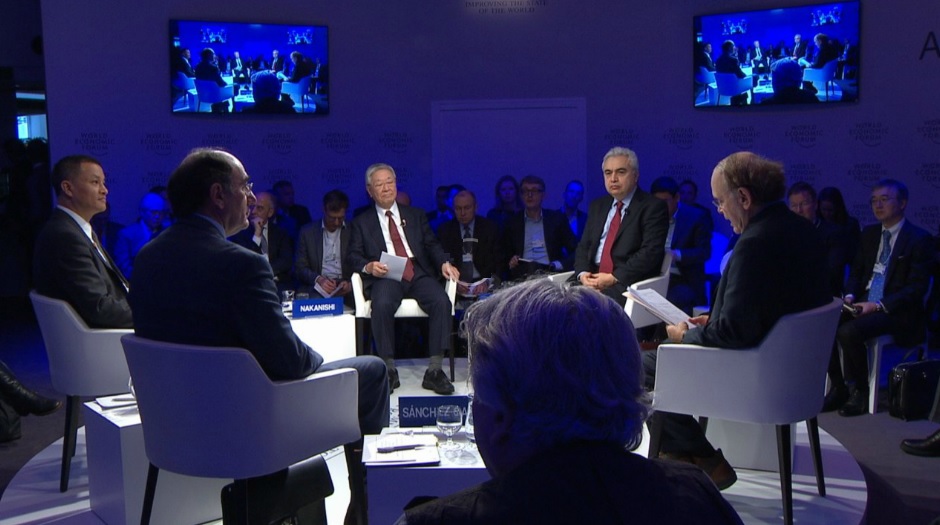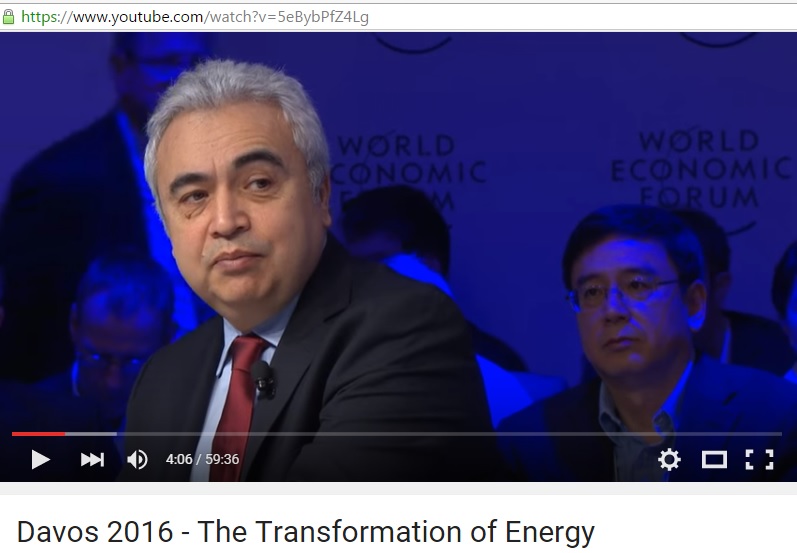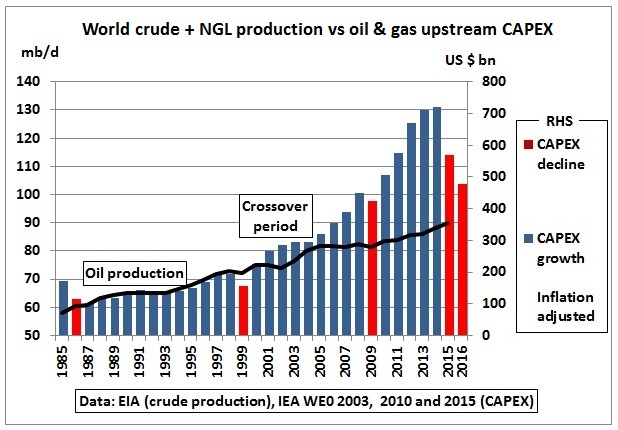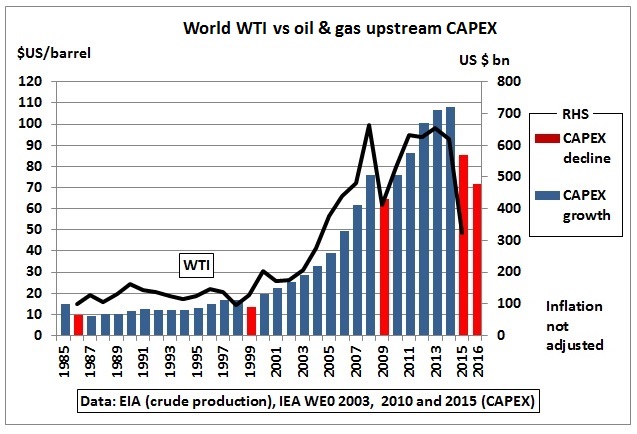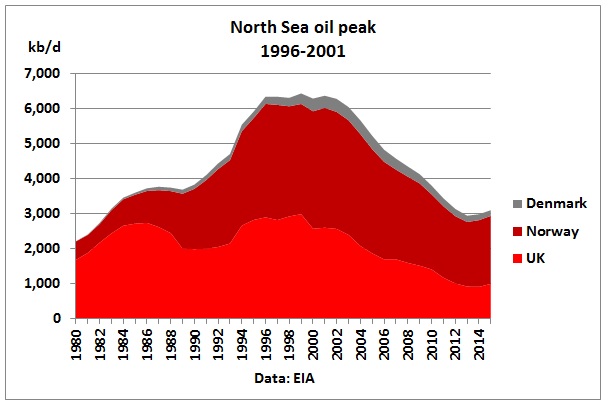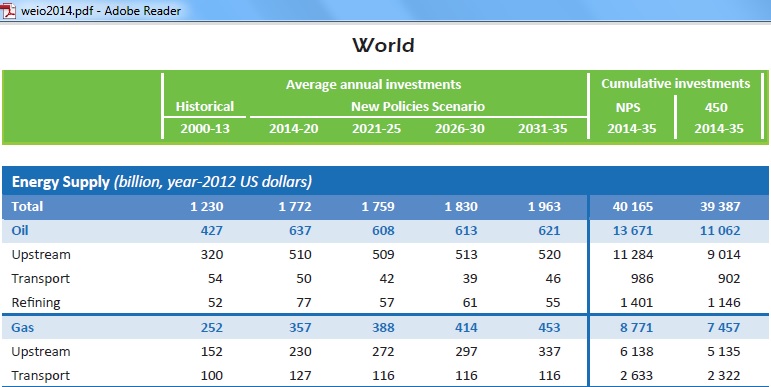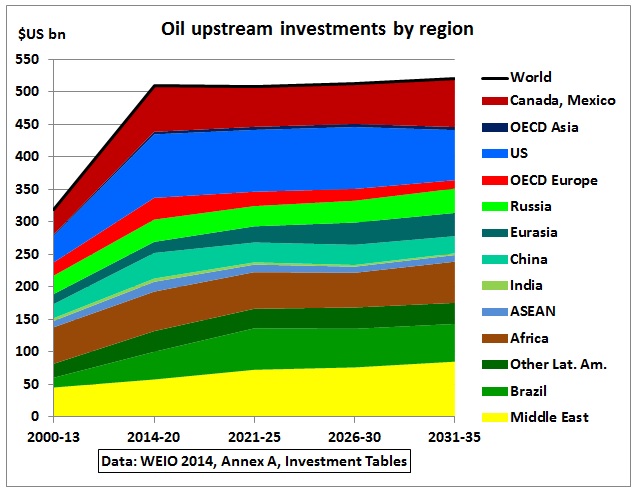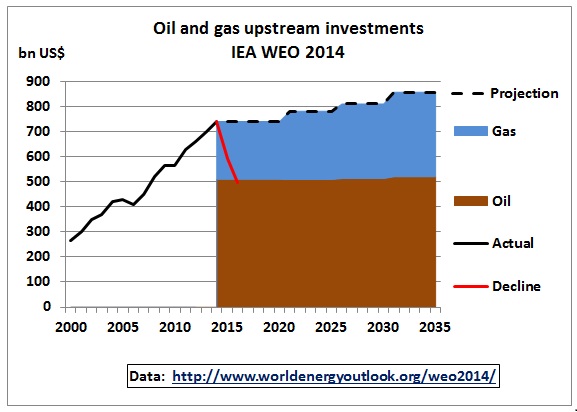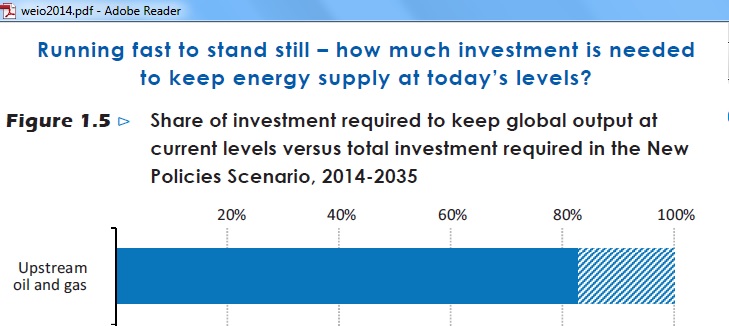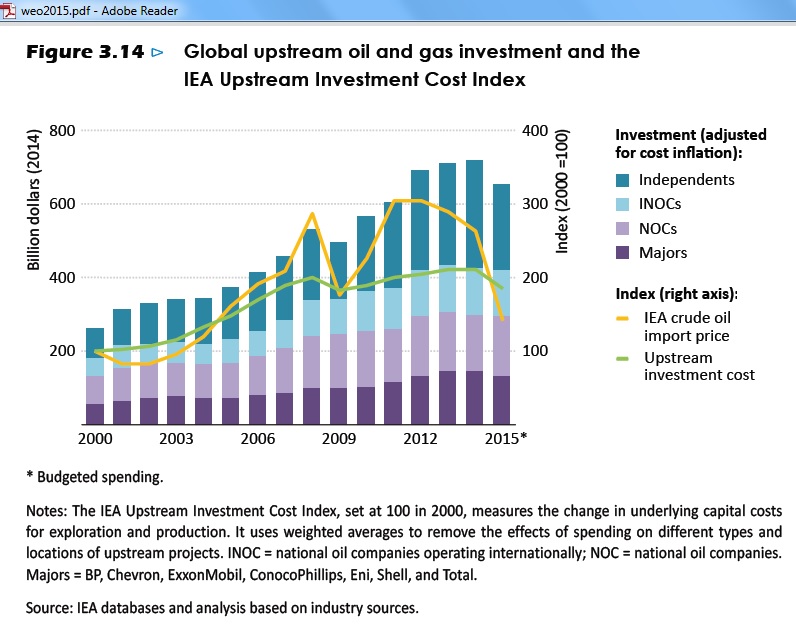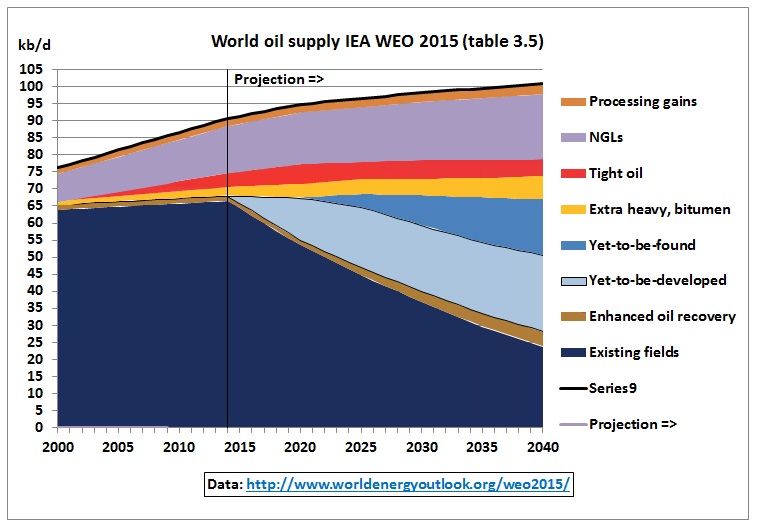World Economic Forum
The Transformation of Energy
Fig 1: WEF energy panellists
22/1/2016 From right to left: moderator Daniel Yergin (IHS), Fatih Birol (IEA), Hiroaki Nakanishi (Hitachi), Ignacio Sánchez (Iberdrola), Eric Xin Luo (Shunfeng International Clean Energy)
This recent forum was about how to transition away from fossil fuels, after the UN conference on climate change in Paris in November 2015. Moderator Yergin – who is a known peak oil denier – started by asking Fatih Birol what low oil and gas prices mean for the development of renewable energies. Fatih responded by first warning about the impact of lower oil prices on investments in the oil and gas sector:
(video 3:24)
Fatih Birol: “For the oil markets what worries me the most is that: last year we have seen oil investments in 2015 decline more than 20%, compared to 2014, for the new projects. And this was the largest drop we have ever seen in the history of oil. And, moreover, in 2016, this year, with the $30 price environment, we expect an additional 16% decline in the oil projects, investments. So, we have never seen 2 years in a row oil investments declining. If there was a decline 1 year, which was very rare, the next year there was a rebound”
Daniel Yergin: “What does that lead you to?”
Fatih Birol: “this leads me to the very fact that in a few years of time, when the global demand gets a bit stronger, when we see that the high cost areas such as the United States start to decline, we may well see and upward pressure on the prices as a result of market tightness. So my message, my 1st message is: don’t be misled that the low oil prices will have an impact on the oil prices in the market in a few years’ time”
Daniel Yergin: “Just to put a number on that. Our numbers at IHS, 2015-2020 we see a 1.8 trillion dollar decline in upstream oil and gas investment”
Fig 2: Fatih Birol, Executive Director IEA
https://www.youtube.com/watch?v=5eBybPfZ4Lg
38:55
Fatih Birol: “…Middle East. If oil prices remain at $30 in 2016, an equivalent of 20% of the Middle East GDP will be erased. It’s a big thing. For Russia, about 10% of Russian GDP will be erased if the prices remain at this level. At the same time for Europe, for China, for India it’s an economic stimulus”
Yergin: “If you look at the global financial markets something is happening there”
“Birol: “It would have been worse if we were in this financial situation with higher oil prices”
Yergin: “So 2 different things going on at the same time”
Birol: “Exactly. But 2 things: one, as I mentioned, these low oil prices and the unprecedented low investments mean we are having a fertile ground in the future for strong rebound in the prices. Second, topic of our discussion, transformation of energy, low oil prices are complicating the transformation. So we have to put this also in the context and therefore a need for governments to be very awake in the presence of low oil prices if they are serious about Paris”
Yergin: “So what should they do?”
Birol: “if they have new policies, they have to stick to them. They shouldn’t get relaxed because the energy prices are low they don’t have the impetus of saving money”
Investment graphs
Let’s have a look at how this 20% decline in investments (CAPEX) looks like. In October 2015 Fatih Birol presented this graph in a slide show in Istanbul:
Fig 3: Oil and gas CAPEX peaked in 2013/14
https://www.iea.org/newsroomandevents/speeches/151002_G20EnergyInvestmentpresentation.pdf
We need to put that into the context of previous capital expenditure. The WEO 2015 has data going back to 2000 and the WEO 2003 back to 1985 (nominal, not inflation adjusted). Adding the estimated additional decline of 16% for 2016, adjusting for inflation and marking the investment decline years in red, we get the following graph:
Fig 4: Upstream investments vs oil production
On the left axis we have global crude and NGL production and on the right axis capital investments needed for this production. It is assumed that oil and gas investments increased together at the same rates.
The above graph uses following CAPEX data
2010-2015 WEO 2015 Fig 3.4
2000-2009 WEO 2010 orange columns in Fig 3.27 (adjusted $2009)
1985-1999 WEO 2003 Fig 4.16 multiplied by 1.73 to match year 2000 of WEO 2010
This is not perfect but is sufficient for our analysis.
We can see that investments grew more than 3 fold since the late 1990s while production went up only by around 50%.
To make this more visible we parallel shift oil production down by 50 mb/d without changing the scale.
Fig 5: CAPEX cross-over period
We see that after a cross-over period between 2000 and 2005 investments went sky high. 2005 was the year in which crude oil production started to peak (production going flat in above graph). The US shale oil boom really started only in 2010/11 (5-6 years too late – waiting for helicopter money from quantitative easing!) but this did not come cheap: CAPEX got another boost. The shale oil bubble burst in 2014.
This explosion in CAPEX came unexpectedly. In November 2003, a couple of months after G.W. Bush declared mission accomplished in Iraq, the IEA wrote in its WEO (p 127):
“The most volatile element in the investment equation is the oil price. Upstream global oil and gas investment in recent years has tended to fluctuate in line with oil prices. A price collapse, such as in 1985 and 1998, typically leads to a subsequent reduction in investment spending. Conversely, higher prices tend to encourage investment spending, as has been seen in recent years (Figure 4.16). The rate of investment, in turn, affects prices. There is also evidence that the increasing short-term volatility of oil prices, by increasing risk and therefore hurdle rates, is constraining investment. Global upstream oil and gas investment is projected to fall significantly from recent record levels as prices fall, though average investment for the current decade, at $117 billion per year, is projected to be significantly higher than that in the 1990s ($93 billion per year).”
http://www.worldenergyoutlook.org/weo2013/
Fig 6: CAPEX vs WTI oil price (nominal)
Yes, in hindsight it is easy to say the IEA prediction was wrong but 2003 was also the year in which it should have been clear to the IEA that the North Sea had peaked. That was the beginning of the problem.
Fig 7: North Sea peak lasted for 5 years
2014 investment outlook
The most recent IEA investment outlook is from June 2014, published 5 months ahead of the usual November schedule and prepared during a period when oil prices were still around $100 a barrel. http://www.worldenergyoutlook.org/weo2014/
The IEA WEIO 2014 writes on p 51:
“Annual investment in upstream oil and gas rises in the New Policies Scenario by one-quarter to more than $850 billion by 2035, with gas accounting for most of the increase. More than 80% of the cumulative $17.5 trillion in upstream oil and gas spending is required to compensate for decline at existing oil and gas fields. A further $5 trillion is required for oil and gas transportation and oil refining.”
“Gradual depletion of the most accessible reserves forces companies to move to develop more challenging fields; although offset in part by technology learning, this puts pressure on upstream costs and underpins an oil price that rises to reach $128/barrel in real terms by 2035.”
“If the oil price stabilises around current levels and increases only moderately to 2035, as anticipated in the New Policies Scenario, governments that have become accustomed to burgeoning hydrocarbon revenues could be in for a difficult process of adjustment.”
Fig 8: Table oil and gas investments to 2035 in the WEIO 2014 (Annex A)
Let’s put those upstream oil investments into a graph
Fig 9: Graph oil investments to 2035 based on WEIO 2014 tables (Annex A)
Total investments are seen to stay basically flat (peak investments!), although the Middle East, Brazil and Eurasia will need increases to offset decreasing investments elsewhere.
In the context of the annual investment history since 2000:
Fig 10: Oil and gas investments to 2035
The graph shows a kink in the investment curve projected in 2014 for the period up to 2035 (dashed line), even before oil prices went down. But this has dramatically changed with investments down by 20% and 16% in 2015 and 2016 respectively (red line).
Fig 11: The unending tread mill of oil production
WEO 2015
18 months later, while oil prices had dropped to $40 a barrel, the IEA WEO 2015 sees investments lower:
“The projections in our New Policies Scenario require cumulative investment in the oil and gas sectors of some $25 trillion, of which just under 80%, or $20 trillion is in the upstream.
This represents an annual average of $750 billion for upstream oil and gas (Table 3.10), a noticeable decrease compared with the $825 billion figure from WEO-2014.
This is due to two effects: first, the lower oil price and the impact that this has on pulling down upstream costs, at least in the medium term; second, the slightly faster shift that we see in this year’s Outlook towards lower cost sources of oil, reflected in the higher market share of OPEC countries in the global oil supply mix. The Middle East, for example, provides 35% of the world’s oil supply to 2040 but requires only 14% of the upstream investment.” p 147
http://www.worldenergyoutlook.org/weo2015/
Investment Cost Index
The slight reduction of cost in 2015 is shown in the following graph with investments by type of oil company, oil import prices and the IEA investment cost index.
Fig 12: Upstream Capex in IEA’s World Energy Outlook 2015
The IEA Upstream Investment Cost Index, which reflects prices for cement, steel and other construction materials and equipment, as well as the cost of hiring skilled personnel and contracting drilling rigs and oilfield services doubled between 2000 and 2008 but then remained on practically the same level until 2014 – despite increasing investments. This means that over time more material and labour was used, indicating that it becomes harder and harder to extract oil.
Decline rates
IEA’s 2013 outlook showed a whopping 8% decline pa in existing fields without investments:
Fig 13: WEO 2013 production decline without investment
The most recent 2015 outlook has a 4% decline in existing (conventional) fields provided there are sufficient investments.
Fig 14: World oil supply to 2040 in the WEO 2015
The graph shows that conventional crude oil production is supposed to be basically flat. This is designed by adjusting the yet-to-be-found wedge. Unconventional tight (shale) oil and heavy oil/bitumen increase only slightly up to 2020. NGLs go up but these don’t play a big role for transport fuels (except LPG).
If 80% of investments are needed just to offset decline, then the additional 2016 drop leads to such a low investment level that yet-to-be-developed projects are in danger, not to mention the assumed production from yet-to-be-found fields. An example of the latter is Shell ending its exploration in the Chukchi sea.
Conclusion
Changes in investment projections were already underway before the 2014 oil price drop. To the extent that oversupply of US shale oil (including condensate filling up US inventories) has contributed to currently low oil prices, the drama evolving now is that unconventional oil – which was originally intended to be added to stagnating conventional supplies in the 1st phase of peaking oil production (2005-2008) – is now endangering this much larger conventional base production, including higher cost offshore fields. Even if oil prices go up again US shale oil has already destabilized global oil markets by increasing volatility. Is that what we call a swing producer? Yes, swinging oil prices and investments. And for those who hope that oil markets will “rebalance” at $60-$70 there is no statistical evidence in the last 10 years that oil prices stayed for very long at these levels.
